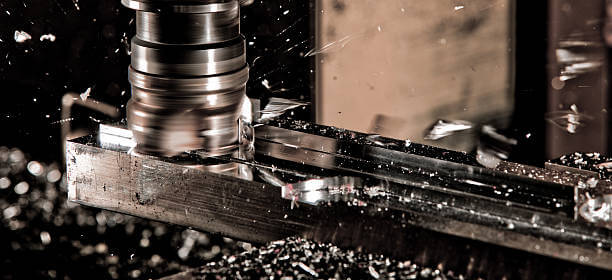Answers & Solutions to Common CNC Milling Problems
From The Experts at Tri Star CNC Services LLC
Milling is a crucial metalworking process utilized across manufacturing industries. However, even the most advanced CNC milling operations encounter a range of issues, impacting part quality, productivity and costs. From tool breakage and burr formation to chatter, excessive wear and dimensional inaccuracies, we'll cover practical solutions to optimize your milling processes. Tackle milling problems head-on! Contact us for professional milling troubleshooting and repair services.

Top 12 Milling Problems With Troubleshooting
1. Breakage
Tool breakage is a severe issue for workpieces and machine tools. It often results from excessive cutting forces due to improper parameters like high feed rates or depths of cut. Lack of rigidity from excessive overhang or runout can also lead to breakage. Adjusting parameters, ensuring rigidity, using appropriate tool paths and optimizing tool conditions are key to preventing breakage.
2. Burr Formation
Burrs, thin projections of material, develop during milling and can harm surface finish as well as subsequent operations. Common causes are worn tools, incorrect tool geometries like cutting angles or helix angles and improper feed rates or depths of cut. Regrinding tools, specifying optimal geometries and fine-tuning cutting parameters are solutions.
3. Built-Up Edge (BUE)
Built-up edges occur when chips are welded to the cutting edge instead of being evacuated properly. Low feeds/speeds, poor coatings for the workpiece material and suboptimal coolant conditions enable this issue. Using appropriate tool coatings, increasing feeds/speeds and enhancing coolant flow/concentration prevent built-up edges.
4. Chatter/Vibration
Chatter is a destructive self-excited vibration caused by a lack of rigidity in the setup and improper operating parameters. Ensuring rigidity of the workpiece, tool holder and machine while optimizing parameters like speeds, feeds and milling strategy is crucial. Proper tool geometries also help avoid chatter.
5. Chip Compaction
Chips can become tightly packed and stuck if not properly formed and evacuated, interfering with cutting. Mitigating this issue involves using tools with sufficient chip room, reducing feed rates and depths of cut, and enhancing coolant flow and air blasting.
6. Deflection
Deflection of the tool from excessive overhang or cutting forces creates tapered walls and dimensional errors. Minimizing overhang, using climb milling, reducing radial depths and feed
rates and increasing tool diameter and flute count reduce deflection.
7. Dimensional Inaccuracies
Tapered walls or over/undersized features often stem from excessive deflection, tool runout, improper feed rates/radial depths or coolant issues. Following recommendations for deflection, runout, parameters and coolant strategy prevents dimensional problems.
8. Excessive Corner Wear
Premature corner wear on the tool reduces tool life and creates poor surface finishes. Using tools with corner radii, reducing speeds, minimizing runout/overhang and specifying appropriate coatings extend corner life.
9. Poor Surface Finish
A rough, irregular surface can result from incorrect feeds/speeds, inadequate radial immersion, tool issues like runout or wear and re-cutting of chips or built-up edges. Optimizing speeds, feeds, tool geometry/condition and chip control provides the desired surface quality.
10. Short Tool Life
Excessive cutting friction, hard workpiece materials, improper tool geometries and coolant/material issues can all lead to short tool life and frequent tool changes. Proper regrinds, using tough coatings, optimizing geometries and enhancing coolant/materials extend life.
11. Wear
Premature wear makes tools dull and ineffective, creating poor part quality. Implementing corner radii, fine-tuning parameters, minimizing runout/overhang, specifying wear-resistant tool materials/coatings and improving chip control/cooling reduce wear.
12. Chipping
Chipping of the cutting edges can rapidly destroy a brand-new tool. Ensuring rigidity, reducing feed rates/radial depths, using proper tool paths/entries, minimizing runout/overhang, specifying tough edge prep/coatings, controlling built-up edges and tweaking parameters can prevent chipping.
FANUC Repair Services From Tri Star CNC
Our certified FANUC technicians have extensive experience troubleshooting and repairing issues with servo amplifiers, spindle amplifiers and other critical components of CNC milling machines. We offer comprehensive field service to diagnose and resolve milling machine problems on-site, minimizing downtime for your operations. From our repair facility, we can quickly repair or replace failed FANUC components like power supply units, and controls to get your milling machine back up and running.
Our parts exchange program provides temporary replacement parts while we repair your original components, allowing you to keep your milling operations moving. With our broad expertise in FANUC systems and machine tool repairs, we troubleshoot and resolve even complex milling machine issues. Contact us today!
WE SERVICE LOCATIONS ACROSS THE UNITED STATES:
California FANUC services
Colorado FANUC services
Connecticut FANUC services
Illinois FANUC services
Indiana FANUC services
Iowa FANUC services
Kansas FANUC services
Kentucky FANUC services
Maine FANUC services
Maryland FANUC services
Massachusetts FANUC services